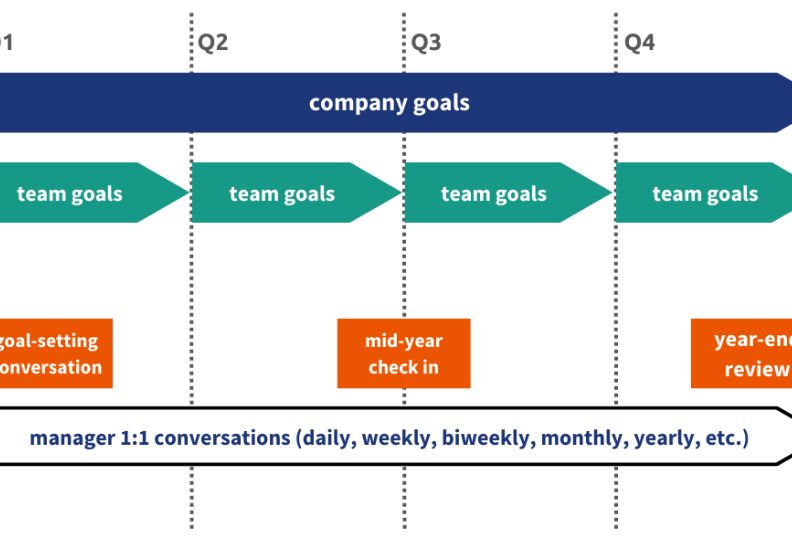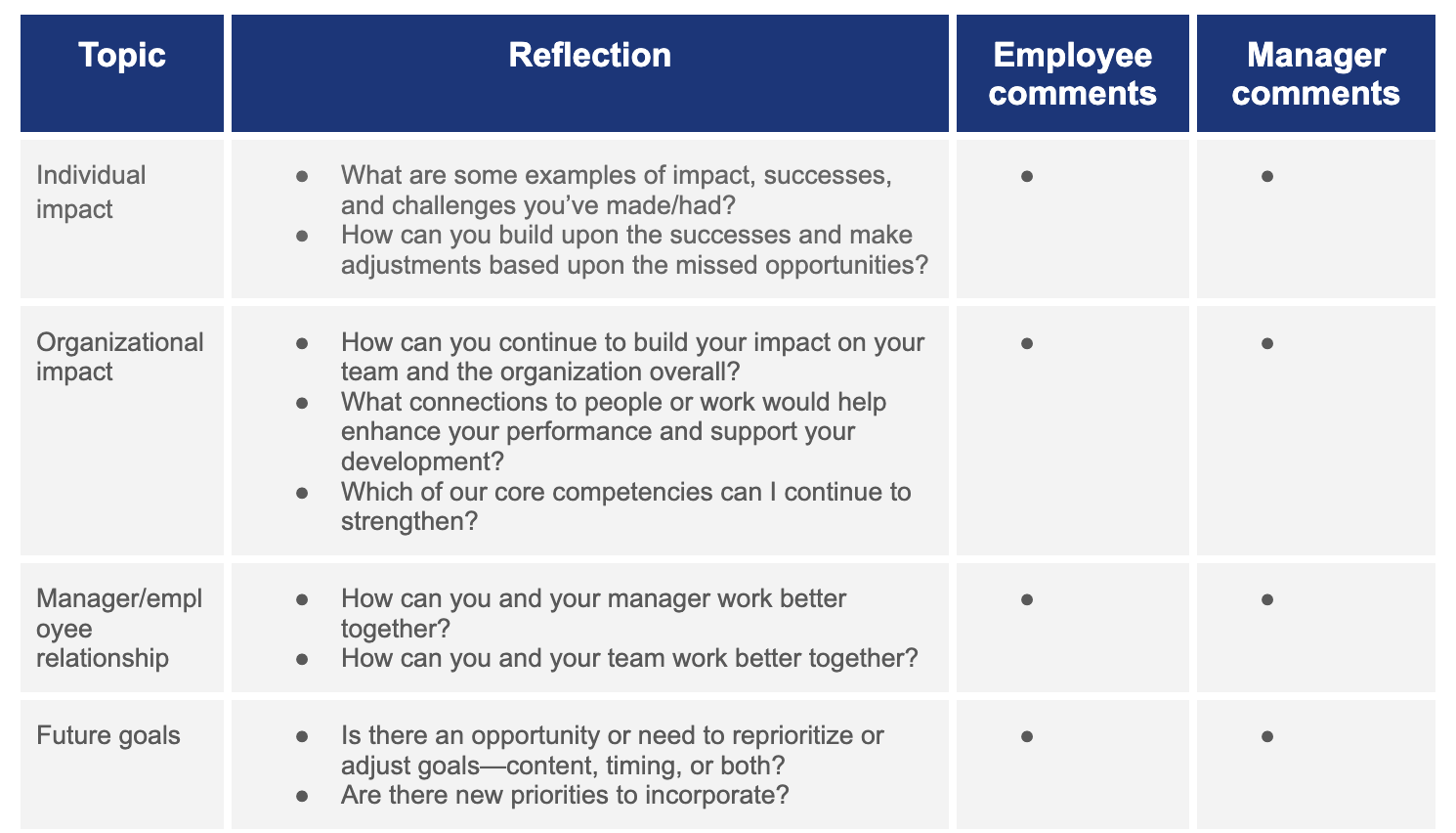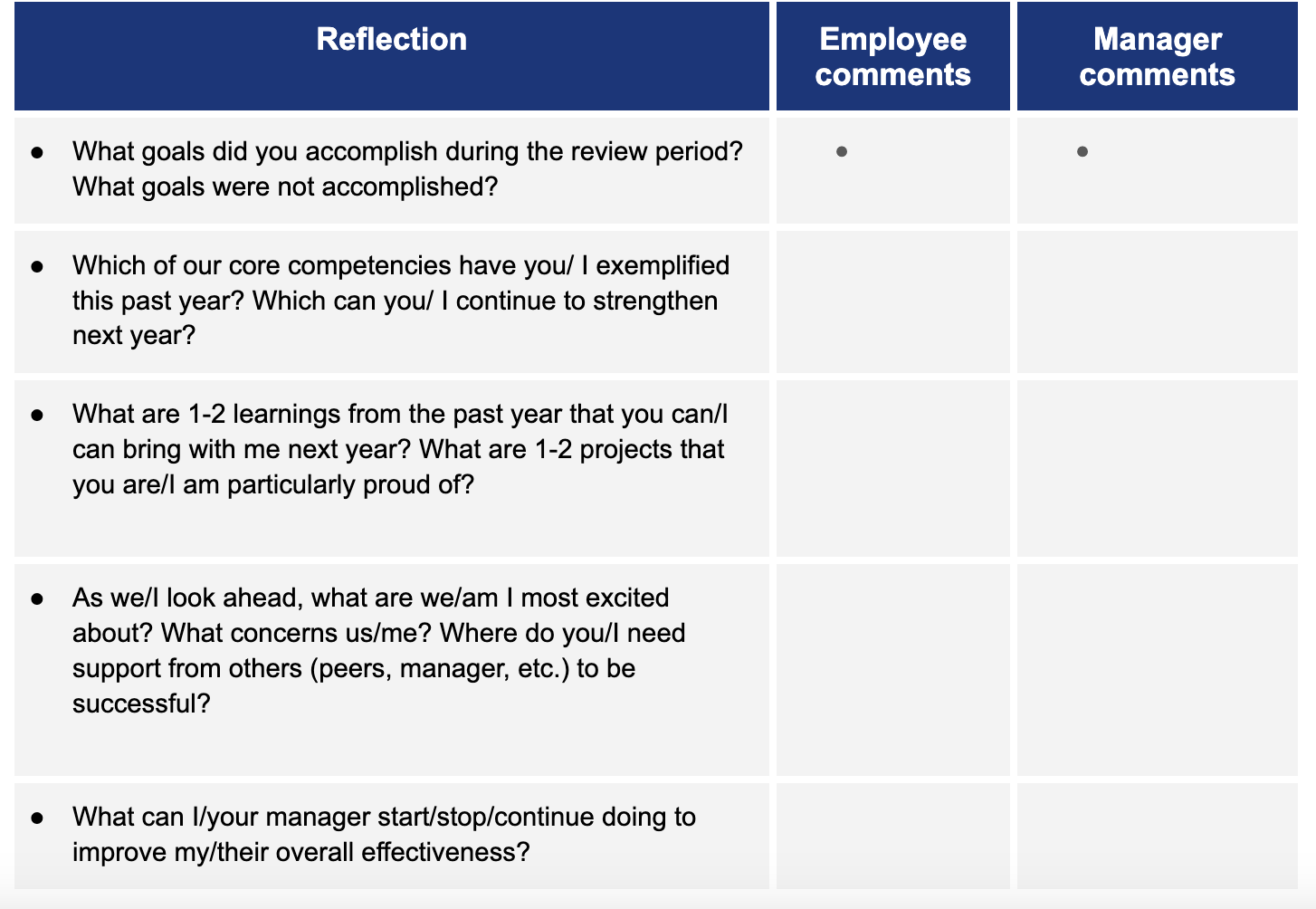How To Make Your Business Goals Click for the Whole Team
Motivate employees by establishing strong communication channels, promoting alignment with company goals, and fostering regular performance and development feedback conversations.

For founders and CEOs, the big picture of what the team is building oftentimes feels quite obvious. The team doing the building, however, doesn’t always agree. Removed from executive level decisions and focused on their day to day work, the ultimate destination—and the milestones to reach those outcomes—can often be unknown or unclear.
Employees tend to want clarity and alignment around their work, their role, and how both tie into company success. Leaders who can establish a deliberate structure and clear communication around those themes:
- provide employees with a clear definition of what “good” looks like in their roles
- connect employees’ day-to-day activities with organizational business objectives
- foster an equitable and inclusive workplace culture
This article will take you through components that establish a rhythm for your team members, clearly connecting them to your organization’s goals and understanding how they can contribute.
- Setting & Revisiting Company Goals
- Defining & Setting Competencies
- Goal-Setting Conversations (Team and Individual)
- Effective 1:1s
- Mid-year Check-in
- Year-End Review
Structuring the Process

Creating some structure contributes to alignment as employees can anticipate and plan for productive and intentional conversations. Here’s a recommended structure:
Q1: Goal-setting conversation
- Review highlights and learnings from the previous year
- Create and communicate company and team goals for the year ahead, and connection to longer term term goals, if applicable
- Set 3-5 individual goals, with 1-2 of them focused solely on career development
Q2/Q3: Mid-year check-in
- Meet with your team to discuss progress against goals and whether or not they are still applicable; if they aren’t, draft and communicate new goals, connected to a ‘why’ for the shift
- Determine goals for the next quarter
Q4: Year end review
- Conduct performance conversations with your team members
Throughout the year
- Hold continuous check ins
- Ensure employees give/receive multi-directional feedback
Setting and revisiting company goals
Before you ask your team members to set individual performance goals, you’ll want to establish them at the company and team levels. Whether you use OKRs, a balanced scorecard, or SMART goals, be sure to define the framework for your team, as different words mean different things to people based on their experience.
Note that in any early stage organization, you will likely need to revisit your goals every quarter or so for relevance. Build in a cadence as part of your existing meeting structure to pause and review, pivot, or confirm. And when you shift your goals, ask yourself– are your employees working on projects that are the most important and impactful to the business?
Defining and setting competencies
We know how important it is to have the right person in the right role at the right time. Competencies are the observable behaviors, knowledge, and attributes that employees are expected to demonstrate on the job. They help you hire, develop, and engage employees. At the end of the day, competencies are an absolute requirement for leaders to hire the right talent and for employees to understand the expected behaviors to be successful and grow within the organization.
Here are a few examples!
- Attention to Detail: Identifies and defines problems, extracts key information from data, and develops workable solutions for problems identified in order to test and verify the cause of the problem and develop resolution. (One quick note—the depth of your competencies will vary by level. For instance, a Sr. Director would be expected to be “expert” while an Associate would be expected to be “developing” in this competency.)
- Teamwork and Collaboration: Actively partners well with all members of the team towards a shared goal while maintaining and encouraging respect and inclusivity. Initiates contact with others to build trusting relationships with colleagues and partners. Puts the needs of the organization, team, or others ahead of self.
- Emotional Intelligence: Demonstrates empathy by effectively reading people, situations, and interpersonal dynamics, especially when working with those from different backgrounds; actively works to minimize the impact of personal implicit biases when interacting with others.
When developing competencies for your organization, consider:
- What do we need from employees in order to achieve overall strategic business objectives in the next ~3-24 months?
- What behaviors do our top performers embody?
- What behaviors are necessary to be successful?
- When performance is lacking, what behaviors are missing?
- Do our competencies use inclusive language and support our commitment to fostering a diverse, inclusive, and equitable culture?
- What range of competencies will result in a more well-rounded workforce?
Goal-setting conversations (team and individual)
While company and team goals tell you where you’re headed, your individual-level goal-setting and review process provides transparency for individual performance and establishes shared accountability between employees, their managers, and the organization.
Goals can span the duration of the year or review cycle period. The SMARTIE framework drives aligned goals at the individual level:
- Strategic: What exactly are you trying to achieve?
- Measurable: How will you know when you’ve achieved it?
- Attainable: Is it genuinely possible to achieve it?
- Realistic: Does it contribute to your organization’s revenue?
- Time-bound: When do you want to achieve this by?
- Inclusive: How will you include traditionally marginalized people into processes, activities, and decision making in a way that shares power?
- Equitable: How will you include an element of fairness or justice that seeks to address system injustice, inequity, or oppression?
Effective 1:1s
Regular touchbases for employees and managers are crucial. They serve as:
- Regular, predictable spaces for employees to bring questions, challenges, and ideas for feedback, insights, and input from their manager
- Opportunities for managers to share both positive and constructive feedback with an employee about their performance, work product, behaviors, etc.
- Platforms for accountability around goal attainment as well as a space for the employee to share roadblocks and obstacles that need to be addressed in order to achieve goals
1:1s aren’t just about checking in on daily work and status updates. They’re about getting to know the people you work with better. They’re about discussing higher-level topics: career goals, professional development, and seeking to understand what motivates individual employees. Are your employees seeking motivation intrinsically (i.e. autonomy, mastery), extrinsically (i.e. salary, public recognition), or a combination of both at work?
Here’s an example of a 1:1 meeting agenda with your direct report. Encourage them to own the agenda!
- Check-In: Discuss how things are going
- Discussion: Any feedback, input, or decisions that your employee needs from you or vice versa
- Updates: Anything that your employee wants to loop you in on
- Roadblocks/support needed: Anything that is getting in your employee’s way
- Action items: Follow-up on any action items agreed to during the last meeting
Mid-year check-in
Nothing should come as a surprise during the mid-year check-in if you’ve been conducting regular 1:1s with your employee. That said, your mid-year check-in differs from a 1:1 because it’s a moment-in-time opportunity to more deeply reflect on the employees’ performance over the last 6 months, together. We recommend a simple template that both managers and employees can use to discuss progress against goals:

Year-end review
A lot can happen over the course of a year! The year-end review is the opportunity for employees and managers to discuss performance over the past 12 months, what was or was not accomplished, what could have been improved, and how they have shown up at work relative to core values and known competencies. Oftentimes an end of year review is an opportunity to reward employees with a merit increase and/or bonus.
During the year end review conversation, both managers and employees can reflect on the following questions.

Going Forward
Helping your team understand company goals and how those relate to their individual priorities is a dynamic process. That’s why we recommend implementing an easily accessible goal setting structure with deliberate feedback loops to set leaders and your team up for success. The sample goal setting structure, questions to consider as you build your competencies, and 1:1 conversation template will establish a solid foundation.
As you look ahead, think about how else you can engage your employees (hint: professional development opportunities) and how you can create paths for growth for your team (hint: talent planning). Need help putting the pieces together? Tap Enspira as a partner to create a structured framework and approach customized to your organization and where you are in your journey.
